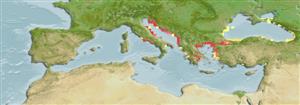Klassifizierung / Names
Namen | Synonyme | Catalog of Fishes(Gattung, Arten) | ITIS | CoL | WoRMS | Cloffa
Environment: milieu / climate zone / depth range / distribution range
Ökologie
seewasser demersal; tiefenbereich 0 - 5 m (Ref. 101253). Subtropical; 47°N - 35°N, 12°E - 42°E
Mediterranean Sea: Adriatic Sea and Aegean Sea. Also known from the Sea of Marmara and the Black Sea.
Size / Gewicht / Alter
Maturity: Lm ? range ? - ? cm
Max length : 5.0 cm TL Männchen/unbestimmt; (Ref. 101253)
Facultative air-breathing in the genus (Ref. 126274); Oviparous. Eggs are demersal and adhesive (Ref. 205), and are attached to the substrate via a filamentous, adhesive pad or pedestal (Ref. 94114). Larvae are planktonic, often found in shallow, coastal waters (Ref. 94114). Omnivore that feeds on small invertebrates, especially crustaceans, detritus and algae (Ref. 101253).
Oviparous, distinct pairing (Ref. 205). Several females spawn at hole guarded by a resident male. Males guard the eggs (Ref. 5981).
Zander, C.D., 1986. Blenniidae. p. 1096-1112. In P.J.P. Whitehead, M.-L. Bauchot, J.-C. Hureau, J. Nielsen and E. Tortonese (eds.) Fishes of the North-eastern Atlantic and the Mediterranean, volume 3. UNESCO, Paris. (Ref. 5981)
IUCN Rote Liste Status (Ref. 130435)
Bedrohung für Menschen
Harmless
Nutzung durch Menschen
Tools
Zusatzinformationen
Download XML
Internet Quellen
Estimates based on models
Preferred temperature (Ref.
123201): 17.6 - 19.9, mean 18.7 °C (based on 192 cells).
Phylogenetic diversity index (Ref.
82804): PD
50 = 0.5078 [Uniqueness, from 0.5 = low to 2.0 = high].
Bayesian length-weight: a=0.00741 (0.00335 - 0.01640), b=3.02 (2.83 - 3.21), in cm total length, based on LWR estimates for this (Sub)family-body shape (Ref.
93245).
Trophic level (Ref.
69278): 3.4 ±0.4 se; based on diet studies.
Widerstandsfähigkeit (Ref.
120179): hoch, Verdopplung der Population dauert weniger als 15 Monate. (Preliminary K or Fecundity.).
Fishing Vulnerability (Ref.
59153): Low vulnerability (10 of 100).
Nutrients (Ref.
124155): Calcium = 300 [58, 1,149] mg/100g; Iron = 2.09 [0.75, 6.99] mg/100g; Protein = 3.24 [0.00, 7.11] %; Omega3 = 0.278 [0.108, 0.748] g/100g; Selenium = 9.1 [1.7, 32.7] μg/100g; VitaminA = 26.7 [6.9, 103.6] μg/100g; Zinc = 1.69 [0.79, 3.50] mg/100g (wet weight);
